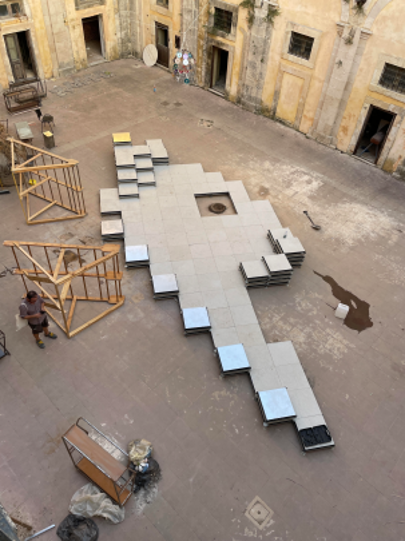Converted Cloisters and a Robot Pigeon: Design in Sicily
All programs developed in partnership with Accent aim to connect the learning experience and the local reality in which students are immersed. Last summer, this was the case for a cohort of 28 students of design from the University of Minnesota, who were participating in an 8-week program in the Sicily Center for Field Studies. At the core of the program were a combination of in-class activities and learning experiences that took advantage of the resources around the city of Syracuse.
 A studio course, taught by UMN faculty Gayla Lindt and Eric Amel, involved both work in the classroom and open-air sketching around Ortygia, Syracuse’s historical island district. Additionally, students worked with instructors from MADE, the Mediterranean Fine Arts Academy of Syracuse. Led by designers Francesca Lantieri and Massimo Tenan, the students carried out an ambitious project to repurpose the former Convent of the Carmelites in Ortygia and convert it into an educational and cultural hub for the local community.
A studio course, taught by UMN faculty Gayla Lindt and Eric Amel, involved both work in the classroom and open-air sketching around Ortygia, Syracuse’s historical island district. Additionally, students worked with instructors from MADE, the Mediterranean Fine Arts Academy of Syracuse. Led by designers Francesca Lantieri and Massimo Tenan, the students carried out an ambitious project to repurpose the former Convent of the Carmelites in Ortygia and convert it into an educational and cultural hub for the local community.
The Convent had in the recent past been used as a fashion design school, but it was now abandoned, its cloister littered with old textbooks and other garbage. Students set out to repurpose the space using their expertise to decorate it by reusing recycled materials, such as archive sketches and old books. For example, as the focal point of the cloister, they created an Ortygia-shaped stage, made of discarded floor tiles. Practical challenges, such as the massive presence of pigeons inside the Convent, were analyzed by the students and turned into a distinctive element: a robot pigeon greeted visitors at the entrance and told them about the convent’s history. The students’ hard work culminated in a grand opening of the hub, which was held on July 1st and advertised throughout Syracuse with fliers designed by the students themselves.
 The program also led students to develop a connection with the local art scene, as they worked with Syracusan photographer Tony Mazzarella. Mazzarella first gave a guest lecture about his work and his studies on Caravaggio, whose paintings are an important source of inspiration for him. He also shared his work on tableaux vivants, a technique used to re-interpret famous paintings through a single photograph set up with actors and scene elements. As final project for their design studio course, students were then asked to work in groups on their own tableaux vivants.
The program also led students to develop a connection with the local art scene, as they worked with Syracusan photographer Tony Mazzarella. Mazzarella first gave a guest lecture about his work and his studies on Caravaggio, whose paintings are an important source of inspiration for him. He also shared his work on tableaux vivants, a technique used to re-interpret famous paintings through a single photograph set up with actors and scene elements. As final project for their design studio course, students were then asked to work in groups on their own tableaux vivants.
Accent has extensive experience designing experiential learning activities that complement and build on the learning objectives of faculty-directed courses. Please reach out to Accent’s Program Development team at development@accentglobal.com if you are interested in discussing these ideas for your current or future study abroad program.